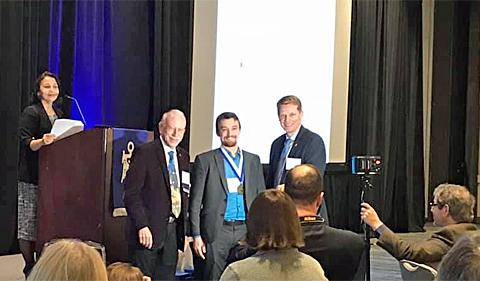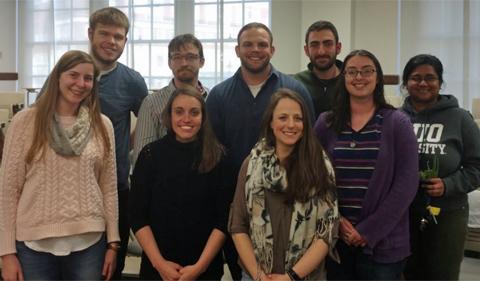
Alumni News: Colin Kruse worked on NASA experiment, now he's tackling national security, energy independence

Four years of cool experiences and mind-bending research weren’t enough for Ohio University alumnus Colin Kruse. He returned for another six years as a staff researcher then graduate student.
Now, he's working to preserve national security and develop sustainable energy independence at the Los Alamos National Laboratory in New Mexico.
Kruse earned two degrees from the College of Arts and Sciences—a B.S. in Chemistry and a Ph.D. in Molecular and Cellular Biology-Plant Biology. He also took quite a few courses in bioinformatics and dance.
It’s what he did outside the classroom that helps tell his OHIO story. And that journey started as an undergraduate researcher in Dr. Jared Butcher’s and Dr. Michael Jensen's chemistry labs, followed by several years as a technician in Dr. Sarah’s Wyatt’s gravity lab before starting graduate school.
There's nothing like being on hand when a truck drives one box all the way from Kennedy Space Center in Florida—to your lab in Athens, Ohio. Even if you were an undergraduate student on the "ground" team in and didn't get to go to Kennedy to watch as OHIO's mascot Rufus snuck a ride aboard a SpaceX Falcon 9 rocket, but instead you got to launch a model rocket at the same time in Athens for the lab's first space experiment.
But at least he got to travel a lot talking about it. He traveled to Honolulu, for example, where he presented on how plants have evolved to use the ever-present stimulus of gravity as a source of information at a conference in Hawaii. Some of his research work was supported by a Student Enhancement Award from Ohio University.
He also went to an international meeting of a scientific research honor society called Sigma Xi—and walked away with an award for best graduate student presentation for his work on tumor genes and new treatment paradigms for cancer.
He had plenty of practice presenting before that, including in the hallways of Porter Hall at the Environmental and Plant Biology Department's annual graduate symposium. He also earned a first place at the Ohio University Student Research and Creative Activity Expo, an annual event featuring more than 850 OHIO students.
Kruse was the lead author on a publication in a scientific journal on how spaceflight affects Arabidopsis seedlings' responses to microgravity. He collected data for that paper as part of Ohio Team Gravitron, sending seedlings to space so that astronauts could germinate them on the International Space Station.
Kruse also joined colleagues in mentoring undergraduates, judging science fairs, removing invasive plants, and more.
Q&A with Colin Kruse
Q: Who were your favorite professors and how did they make an impact on your life?
A: Top of the charts is Dr. Sarah Wyatt. She mentored me with no nonsense and made me realize a passion for research excellence—and made me realize the how and when of being a true professional.
Dr. Jared Butcher made me challenge myself to be a creative scientist and taught me the value of collaboration to make tangible changes to the world through science.
Dr. Michael Jensen was an ultimate brainiac and taught me the cruel world of inorganic chemistry research. His brain moved so fast I always had to struggle to keep up, but never wasted a minute in his presence!
Last but not least, Dr. John Kopchick taught me how to network, to team-build, and how much a single contact or an unexpected result can change your life forever. Not to mention that you can be a world-class scientist and still have fun!
Q: Do you still keep in touch with any of your faculty?
A: I do! I never miss the opportunity to catch up with Dr. Wyatt or any of my other mentors. It is a rare privilege to get to interact with heroes/mentors as a fellow PhD.
Q: What was your ah-ha moment at OHIO—that point where you said to yourself, “I’ve got this!”?
A: While doing work in Dr. Jensen's lab, I used general chemistry reactions (double replacement) to make a compound no one had been able to synthesize before. It was a rare moment of pride to get to think outside the box and leverage the simplest of chemistry to tackle a complex challenge (and it led to my first publication)!
It was either that or my third straight intramural broomball championship!
Q: What was the hardest hill you had to climb (not counting Jeff Hill) at OHIO? And how did you overcome challenges or obstacles in your path?
A: Homework/discipline. I had to fight myself to go to class and do homework more than I care to admit. Dr. Jeffrey Rack sent me the ultimate "get your act together" email that helped me get my head on straight and realize that work ethic is just as important for success as intelligence.
Q: What are your favorite OHIO memories?
A: The leaves falling on East Green in September or October and the hysterical laughter of an all-nighter in Alden Library or the classics library in Ellis Hall, desperately preparing for finals with colleagues and friends.
Q: What’s the one thing you would tell a new OHIO student not to miss?
A: Office hours and time with professors. You won't have access to such a diverse set of brilliant people ever again! Meet them, learn from them, and grow. And take some classes that are outside the box. I wouldn't be who I am today if I hadn't done African dance with Drs. Zelma Badu-Younge and Paschal Younge.




